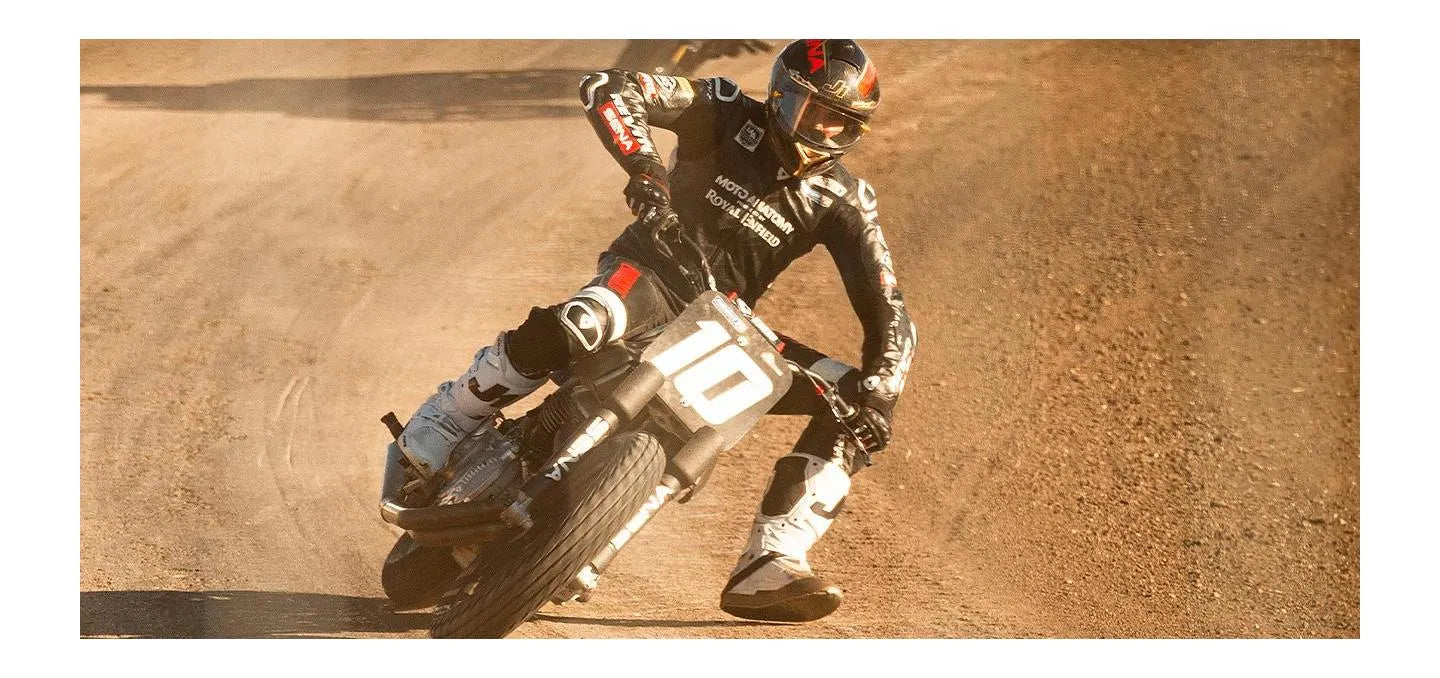America’s gift to the world
REV’IT! rider Johnny Lewis explains the purpose of a steel shoe in flat track, a century-old form of motorcycle competition that Gerald Foster, author of “The Complete Book of Flat Track Racing,” called, “America’s unopened gift to the world.”

“The racing is as close as you can get — handlebar to handlebar, elbows and knees — at speeds up to 130 mph,” explains Lewis, a series veteran who represents the Moto Anatomy X Powered by Royal Enfield team. “We’re rubbing into each other from the middle of the straight all the way into the corner.”



So simple but so unique

Billed as “America’s original extreme sport,” flat track is rooted in a century of competition, headed by longstanding events like the Springfield Mile and the Peoria TT. “Flat track is a pretty historic type of racing,” says Lewis. “The connection is that it is so simple but so unique.”
Part of what makes flat track unique is the steel shoe that every rider wears over his or her left boot, regardless of experience or class of competition. All that clanking and scraping makes for noisy pits and prompts newcomers to ask, "Why are those riders limping?"
The Shoe Man
Decades later, Lewis echoes Maely’s thoughts. “If you’re going down a straightaway with your feet on the footpegs, 100% percent of the bike’s weight is on the tires,” he says. “When we take our left foot off the footpeg and stick it out entering a corner, now less than 100% of the weight of the motorcycle is on the tires.
“If the track has more traction, we might put more weight on our foot to loosen up the motorcycle. Now, I have 30% of the weight of the motorcycle on my foot and the remaining 70% is split between the front and rear tires. Usually, that split is pretty even.”

Like the rudder of a boat

For decades, flat-trackers wore traditional lace-up lineman’s boots, around which Maely and the like practiced their craft. Lightshoe’s Gary Kinzler, who builds Lewis’ steel shoes, offers packages for road-race, trials, and motocross boots. Lewis favors the latter option.
“Gary knows where I put my foot, how I angle my foot,” says Lewis. “He adds material in one spot, and because he knows how I plant my foot — pinky toe first — he shapes the shoe a little differently. That edge helps me glide across a really bumpy or tacky spot on the track.”
Motorcyclists are told to look where they want to go. For flat-trackers, the left foot leads the way. “I point my foot in the direction I want to go,” Lewis says. “If you study photos, you can see my pinky toe pointing to the inside of the track, where I want to go. It’s also where my eyes should be looking and my chest should be facing.
“I point the inside toe, and as I put my foot down, the weight goes back to the heel. So, the outer left side of the shoe gets a wear spot. The rest of the shoe almost doesn’t matter. I can wear down a steel shoe pretty quickly, because I am consistently hitting the same spot.
Flat-tracker’s fingerprint
Those wear spots are a flat-tracker’s fingerprint. “I can tell from the wear marks on the steel shoe how a rider puts his foot down. At my school, I ask my students, ‘Let me see your steel shoe.’ I can look at it and say, ‘You’re doing this or you’re doing that.’ They’re like, ‘How did you know that?’”

Like flipping a switch
“If I did that riding flat track, pointing my toe away from the direction of travel, I would have to use more upper body to turn the bike. Then, the front end of the bike would push. Rotating the foot changes the hip position, chest position, shoulders, arms, head, and eyes. It’s like flipping a switch. Everything reacts to that foot.”
Speedway riders also wear steel shoes, but the shape of the shoe is different. “Once a speedway rider gets fast at flat track,” Lewis says, “he can’t use the speedway shoe because he keeps catching his foot. He actually needs the flat-track shape. Flat track is that specialized.”
Shiny steel toe
An all-American flat track racer through and through, Coatesville, Pennsylvania born Johnny Lewis has settled into the groove in American Flat Track Championship aboard his iconic number 10 Royal Enfield machine. After winning the prestigious AMA Sports Athlete of the Year award in the flat track category in 2004, racking up several national flat track championships, and a switch to racing supermoto professionally across the US, REV’IT! Rider Johnny Lewis has become a staple in the American Flat Track scene since his full-time return to the series in 2009. After founding his Moto Anatomy flat track riding school in Center Hill, Florida in 2015, Lewis has been sharing his experience in teaching new riders the secrets of the slide as well as being invaluable in developing Royal Enfield’s bid to conquer the Production Twins class in AFT.







